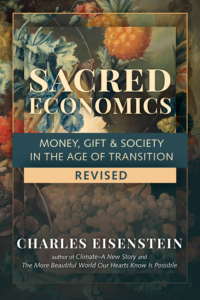Climate — A New Story
Chapters
Chapter 4: The Water Paradigm
The Organs of Gaia
Forests are certainly not the only Gaian organ crucial to the maintenance of life. Based on the principle that life creates conditions for life, the most important organs would be the ones that are most abundant with life: forests, wetlands, estuaries, coral reefs, and rich grasslands with their vast herds of animals. All are in steep decline around the world, while the biota-poor areas—the deserts and oceanic dead zones—are spreading.
The carbon fundamentalist paradigm has brought welcome attention to wetlands, forests, seagrass, and prairies, which have enormous carbon storage and sequestration capacity. The ten-foot-thick topsoil of the American Midwest testifies to that capacity and to the disastrous consequences of tilling the land and exposing the soil to erosion and oxidation of its organic matter into CO2. I will look at these non-forest ecosystems, together with cultivated land, through the carbon lens in the next chapter.
Looking past carbon to water and beyond, we see even more clearly the acute planetary importance of these ecosystems. Virgin grasslands exercise many of the same functions that forests do, effectively soaking up rainfall and protecting soil, preventing flooding, ameliorating drought, seeding cloud formation, and building the water table. The thick mat of sod softens the impact of rain on soil, preventing erosion; the carbonaceous soil organic matter that the roots deposit over time is a sponge for rainwater, binding it to organic molecules and slowing evaporation as well.
Just as a forest is more than a collection of trees, a grassland is more than a concentration of grass. It is a living ecosystem that also includes herbivores, predators, and invertebrate multitudes. Earthworms aerate the soil and produce rain-storing humic aggregates; herd animals crop, trample, and fertilize tall grasses that then become mulch and eventually soil. Fungi bind earthworms, bacteria, roots, insects, and each other into complex communities that cycle nutrients and exchange chemical information. Each member of the grassland is alive, and the totality is alive too.
If forests, grasslands, wetlands, coral reefs, etc., are among Gaia’s vital organs, then perhaps species can be seen as her cells and tissues. They may not have a visible, direct effect on carbon or water cycles—but then again they may. A traditional Navajo proverb went, “Without the prairie dogs, there will be no one to cry for rain.” That seems like bald superstition, except that the near-extirpation of prairie dogs in the twentieth century indeed coincided with declining rainfall in the American Southwest. And now it turns out that the Navajo belief was not so superstitious after all, but rather an astute insight into ecological hydrology. Bill Mollison, preceptor of the permaculture movement, wrote, “Amused scientists, knowing there was no conceivable relationship between prairie dogs and rain, recommended the extermination of all burrowing animals in some desert areas planted to rangelands in the 1950s ‘in order to protect the sparse desert grasses.’ Today the area has become a virtual wasteland.”[20] Mollison offered the explanation that the burrows of prairie dogs and other animals are like lung alveoli. As the moon passes overhead, tidal forces bring up water from aquifers closer to the surface, providing moisture for rain. Judith Schwartz adds that prairie dog tunnels allow rainwater to penetrate the ground instead of running off, thereby replenishing aquifers;[21] prairie dogs also control water-hogging mesquite.
Wetlands, as the name suggests, are also crucial for a healthy water cycle. They slow the migration of water from land to sea, giving it time to soak down into aquifers and evaporate up into the atmosphere to be a source of rainfall. Wetlands have been in decline throughout history as human beings drained them for agricultural purposes, a process still under way today. The current landscape of North America, with its brooks, streams, and rivers running through well-defined channels, is actually the result of severe land modification. According to researcher Steve Apfelbaum, “Many currently identified first, second, and third-order streams were identified as vegetated swales, wetlands, wet prairies, and swamps in the original land survey records of the U.S. General Land Office.”[22] Owing to civil engineering projects (such as the straightening of meandering rivers for navigation) as well as the near-extirpation of beavers, the slow progress of water from land to sea was greatly hastened: flow rates of rivers increased by orders of magnitude. Globally, this means that the land is losing water faster than it receives it, making drought an inevitability and contributing to the rise of sea levels.
Ironically, a large part of wetlands destruction in recent times is done in the name of fighting climate change, since big hydroelectric projects often involve severe hydrological disruption. The African Sahel was once home to vast, fecund wetlands of incredible biodiversity, fed by seasonal floods. They have been in steep decline since the dam-building era began in the 1980s, encouraged by development agencies to generate electricity and control floods. As a result, Lake Chad stands at 5 percent its former surface area. Social disruption has followed, fueling Boko Haram and waves of migration to Europe. Next in line is the Inner Niger Delta, a vast wetland the size of Belgium threatened by a new mega-dam planned in Guinea.[23] Writing in Yale Environment 360, Fred Pearce observes, “Dried-up wetlands are often blamed on climate change when the real cause often is more human interference in river flows.”[24] How convenient it is to blame climate change, compared to questioning a basic strategy of Third World development.
I will mention two more biomes here that are normally excluded from that category: agricultural land and urban land. As I will discuss later, the healing of this planet is not a matter of humanity stepping out, creating a separate human realm and leaving nature untouched. It will not come through minimizing our impact; it will come through changing the nature of our impact. It will come through a different kind of participation in nature, one where humanity returns to being an extension of, and not an exception to, ecology.
As it stands, wherever modernity has spread, lands heavily influenced by humans are damaged lands, ailing lands, unable to fulfill their function in maintaining Gaian homeostasis. Naked soil, such as that plowed up for farming, is almost never seen in nature, and for good reason. It is like an open wound, flesh without skin, that quickly loses its life-giving moisture and blows away. Baked by the sun and lacking a root structure to hold it and aerate it, it can neither absorb as much moisture when it rains, nor hold that moisture very long thereafter. Chemical-intensive agriculture adds injury to injury by destroying earthworms and other soil organisms that help water penetrate to deeper soil layers. Not only do earthworms increase soil moisture capacity, they and the soil ecosystems they facilitate increase soil carbon storage and promote the growth of methanotrophs—bacteria that feed off methane and reduce levels of this greenhouse gas.[25]
Not only do naked, disturbed soils hemorrhage carbon into the atmosphere, they also contribute to direct regional warming: one study notes the correlation between the increase in cover cropping in the Canadian grain belt, lower summer temperatures, and higher humidity and rainfall.[26] Cover cropping is part of a growing regenerative agriculture movement that seeks to restore water and soil through farming.
Other modern agricultural practices that compound the damage to water and soil include:
- The creation of large, unbroken fields without hedgerows, wild or wooded patches, or contours to slow down water and stop erosion during heavy downpours
- The use of heavy tractors, which compact the soil and make it less permeable
- Irrigation that makes soil increasingly salty
- Heavy use of chemical fertilizers, herbicides, fungicides, and insecticides that destroy soil biota
These and other unsustainable practices will stop when we understand that human well-being is inseparable from the well-being of soil and water.
In urban environments the damage to soil is even more severe; often it is paved over entirely. Unable to filter into the earth, the water is a nuisance that is sluiced away through drainage systems as “wastewater,” returning swiftly to the ocean without entering the hydrological cycle of evapotranspiration or groundwater recharge. Meanwhile, cities draw down surrounding water resources to meet their use needs.
Without much vegetation to transpire water and cool the air, cities are subject to the urban heat island effect. The heat affects wind patterns, generating high pressure systems that push precipitation into surrounding areas—for example, cooler mountain regions—which then experience torrential downpours, erosion, and flooding.[27] To a lesser degree, any devegetated area (such as plowed fields) becomes a heat island that generates high pressure and pushes rain away to mountains or the ocean.
Climate change skeptics sometimes cite the heat island effect to claim that global temperature data is skewed, since temperature gauges are increasingly located in or near urban heat islands. Even if true, that is of scant consolation if the whole planet is becoming a heat island due to urbanization, development, and deforestation. The effects are not only local; through their disruption of hydrological heat transport they influence global temperature as well as drought and flood, often through complex, nonlinear chains of causation. For example, deforestation and wetlands draining along Europe’s Mediterranean coast have led to decreased evapotranspiration and fewer summer storms near the coast but more intense storms in central Europe. Fewer coastal storms then leads to salinization of the Mediterranean and changes in the Mediterranean-Atlantic salinity valve, which in turn intensifies Atlantic storms and changes weather patterns as far away as the Gulf of Mexico.[28]
As the paramount environmental narrative today, climate change obscures the much larger, more direct, and more local influence of “land management changes” in causing drought, flooding, heat waves, and other kinds of extreme weather. Climate change, instead of being an incentive to enact more ecologically beneficial policies, becomes a convenient scapegoat that diverts attention from effective local measures and shifts responsibility for ecological healing onto distant, global institutions.
For example, understanding that deforestation and soil tillage lead to topsoil erosion, which makes the land unable to absorb rainwater, which then leads to flooding, one necessarily must respond locally: conserving forests and wetlands, practicing organic no-till agriculture, and rebuilding soil. Ignorant of these things, the environmentally concerned person is left with actions like putting solar panels on the roof or offsetting jet travel by donating to a tree planting fund. Environmental zeal stays focused far from home, and most of the damaging activities continue.
I write these words in the aftermath of Hurricane Irma and Hurricane Harvey, proclaimed by the media to have been exacerbated by climate change. While I understand the scientific logic behind that claim—warmer water evaporates more quickly, warmer air can hold more water, etc.—the argument appears tenuous under close examination.[29] Total accumulated cyclone energy has not appreciably increased in recent decades, nor has total precipitation, storm frequency, or storm strength. Regardless, the controversy over whether climate change is responsible deflects attention from local factors that make such storms more damaging to humans and ecosystems. Chief among them, at least in Florida and Texas, is the widespread draining of wetlands, which can soak up rainwater and buffer storm surges. Both regions have also experienced deforestation, agricultural soil abuse, and extensive suburban development. Blaming climate change obscures these factors and allows these practices to proceed as usual.
As with flooding, so with drought. I recently read an otherwise insightful article on immigration by Vijay Prashad that stated, “The causes [of emigration from Central America] should be found in the collapse of agriculture in these countries—driven largely by climate change induced drought and flash floods, extreme heat and forest fires.”[30] Let’s leave aside for a moment the economic and political causes of the collapse of agriculture, such as free trade agreements that make traditional peasant agriculture uneconomic, benefit transnational agribusiness, and turn the agricultural economy toward exportable commodities. While global climatic patterns (namely, the strong El Niño of 2015–16) precipitated the latest famine, these countries have also suffered intense deforestation. Guatemala lost 17 percent of its rainforest in just fifteen years from 1990 to 2005; subsequently the rate of deforestation accelerated threefold;[31] losses have been especially heavy in its famous cloud forests.[32] A similar story transpired in Honduras, which lost 37 percent of its rainforests in the same period with no letup in sight. El Salvador is the saddest case of all, having suffered 85 percent deforestation since the 1960s. When these forests are cut down, rainfall runs off instead of being absorbed to recharge the water table, resulting in erosion, landslides, and flooding. Springs dry up, rainfall decreases, and the local climate becomes hotter and drier. The stage is set for devastating drought.
Before deforestation, the rainforests of South and Central America received plenty of rainfall, El Niño or not. That’s why they are called rainforests. Moreover, El Niño (a weather pattern that brings drought and heat waves to much of the northern hemisphere) has been rising in frequency and intensity since the 1970s. Typically blamed on “climate change,” it may also be a by-product of deforestation, particularly in Indonesia, where severe deforestation may weaken the persistent zone of low pressure that helps drive the Walker circulation, whose weakening results in El Niños.[33]
Blaming climate change for Central American droughts diminishes the urgency of addressing local deforestation, shifting emphasis onto global-scale solutions. It relegates to secondary importance a whole complex of other causes far beyond deforestation. Besides, what causes deforestation? Whether in Central America or elsewhere, the causes can include:
- Changing weather patterns caused by previous deforestation and soil degradation
- International free trade agreements, which make traditional, sustainable farming practices economically unviable and demand conversion of forests into ranches and monocrop plantations
- The ideology of development, which makes traditional, sustainable peasant agriculture seem backward
- The erosion of indigenous land-based spiritualities that held protecting land and water as a sacred duty
- Foreign debt owed by forested less-developed countries that pressures them to convert those forests into commodities
- Establishment of legalized property rights in places where informal communitarian land ownership was an obstacle to development
- The extermination of large predators that kept herbivores in population equilibrium with their environment
- Government policies that bring nomadic and indigenous people into the mainstream of industrial society, so that they can no longer tend the wild
- Population pressure leading to the cutting of trees for firewood
- Illegal logging facilitated by “corruption”—which is actually the incursion of translocal monetized relationships into preexisting gift-based structures
- Unpredictable knock-on effects of ecological disruption caused by draining wetlands, spraying chemical poisons for “weed” and “pest” control, and exterminating crucial species like beavers, prairie dogs, and wolves; elephants, rhinos, and lions
Obviously, these are not isolated dysfunctions in a fundamentally sound system. The system itself, and the Story of Separation woven through it, generates the dysfunctions. If pressed to distill them down to a single culprit, I would say it is the truncating, the simplifying, and the impoverishing of relationships—human to human and human to world. And if I were pressed to offer a universal solution, it would be to see and treat the world as sacred again.
If anything on earth is sacred, it should be water. So far I have actually not upheld it as sacred in this discussion; I have merely illuminated the bad things that are happening to ourselves and the planet through the maltreatment of water, trees, and soil. To treat them as sacred we must go beyond that. As my friend Orland Bishop says, the sacred is something that requires a sacrifice; that is, it is something we value—and would sacrifice to protect—beyond its use-value to ourselves.
Other cultures upheld the sacredness of water through ceremonies and taboos, protecting water from anything that would insult or pollute it. I do not advocate imitating indigenous ceremonies; rather, we can find a contemporary counterpart that draws from their knowledge and fits into our own evolving story-of-the-world. Our water technologies will take on the energy of ceremony when they draw from the perception that indigenous and traditional people have held of water, that it is a living being. The door to that is opening as the familiar scientific conception of water as a homogeneous, structureless chemical fluid becomes obsolete.[34]
The hydrological arguments of this chapter offer a nudge toward treating water as sacred, but do not touch on other water issues that are more difficult (to our current way of knowing) to connect to climate change. One day, though, I am sure that we will learn that contaminating water with pesticides, pharmaceutical residues, industrial chemicals, and radioactive waste will threaten planetary well-being just as much as deforestation or greenhouse gas emissions. Water is life. What we do to water, we do to life.
End Notes
[20] Quoted in Buhner (2002).
[21] Schwartz (2016), 82.
[22] Apfelbaum (1993).
[23] Pearce (2017).
[24] Ibid.
[25] Biodiversity for a Livable Climate (2017).
[26] Ibid.
[27] Kravčík et al. (2007).
[28] Millán (2014).
[29] See NOAA (2018).
[30] Prashad (2017).
[31] All of these figures come from Mongabay (2018), which has a heartbreaking catalog of deforestation trends around the world.
[32] Community Cloud Forest Conservation (2018).
[33] Hance (2012).
[34] See my essay “The Waters of Heterodoxy” (Eisenstein, 2014) for an in-depth discussion of this point.






